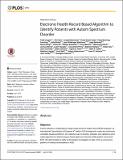Electronic Health Record Based Algorithm to Identify Patients with Autism Spectrum Disorder

View/
Author
Lingren, Todd
Chen, Pei
Bochenek, Joseph
Doshi-Velez, Finale
Manning-Courtney, Patty
Bickel, Julie
Wildenger Welchons, Leah
Reinhold, Judy
Bing, Nicole
Ni, Yizhao
Barbaresi, William
Mentch, Frank
Basford, Melissa
Denny, Joshua
Vazquez, Lyam
Perry, Cassandra
Namjou, Bahram
Qiu, Haijun
Connolly, John
Abrams, Debra
Cobb, Beth A.
Lingren, Nataline
Solti, Imre
Hakonarson, Hakon
Harley, John
Note: Order does not necessarily reflect citation order of authors.
Published Version
https://doi.org/10.1371/journal.pone.0159621Metadata
Show full item recordCitation
Lingren, T., P. Chen, J. Bochenek, F. Doshi-Velez, P. Manning-Courtney, J. Bickel, L. Wildenger Welchons, et al. 2016. “Electronic Health Record Based Algorithm to Identify Patients with Autism Spectrum Disorder.” PLoS ONE 11 (7): e0159621. doi:10.1371/journal.pone.0159621. http://dx.doi.org/10.1371/journal.pone.0159621.Abstract
Objective: Cohort selection is challenging for large-scale electronic health record (EHR) analyses, as International Classification of Diseases 9th edition (ICD-9) diagnostic codes are notoriously unreliable disease predictors. Our objective was to develop, evaluate, and validate an automated algorithm for determining an Autism Spectrum Disorder (ASD) patient cohort from EHR. We demonstrate its utility via the largest investigation to date of the co-occurrence patterns of medical comorbidities in ASD. Methods: We extracted ICD-9 codes and concepts derived from the clinical notes. A gold standard patient set was labeled by clinicians at Boston Children’s Hospital (BCH) (N = 150) and Cincinnati Children’s Hospital and Medical Center (CCHMC) (N = 152). Two algorithms were created: (1) rule-based implementing the ASD criteria from Diagnostic and Statistical Manual of Mental Diseases 4th edition, (2) predictive classifier. The positive predictive values (PPV) achieved by these algorithms were compared to an ICD-9 code baseline. We clustered the patients based on grouped ICD-9 codes and evaluated subgroups. Results: The rule-based algorithm produced the best PPV: (a) BCH: 0.885 vs. 0.273 (baseline); (b) CCHMC: 0.840 vs. 0.645 (baseline); (c) combined: 0.864 vs. 0.460 (baseline). A validation at Children’s Hospital of Philadelphia yielded 0.848 (PPV). Clustering analyses of comorbidities on the three-site large cohort (N = 20,658 ASD patients) identified psychiatric, developmental, and seizure disorder clusters. Conclusions: In a large cross-institutional cohort, co-occurrence patterns of comorbidities in ASDs provide further hypothetical evidence for distinct courses in ASD. The proposed automated algorithms for cohort selection open avenues for other large-scale EHR studies and individualized treatment of ASD.Other Sources
http://www.ncbi.nlm.nih.gov/pmc/articles/PMC4966969/pdf/Terms of Use
This article is made available under the terms and conditions applicable to Other Posted Material, as set forth at http://nrs.harvard.edu/urn-3:HUL.InstRepos:dash.current.terms-of-use#LAACitable link to this page
http://nrs.harvard.edu/urn-3:HUL.InstRepos:29002605
Collections
- HMS Scholarly Articles [17921]
Contact administrator regarding this item (to report mistakes or request changes)


